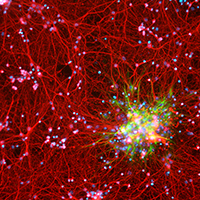Quantitative, structural and molecular changes in neuroglia of aging mammals: A review

Accepted: 27 May 2021
HTML: 11
All claims expressed in this article are solely those of the authors and do not necessarily represent those of their affiliated organizations, or those of the publisher, the editors and the reviewers. Any product that may be evaluated in this article or claim that may be made by its manufacturer is not guaranteed or endorsed by the publisher.
Authors
The neuroglia of the central and peripheral nervous systems undergo numerous changes during normal aging. Astrocytes become hypertrophic and accumulate intermediate filaments. Oligodendrocytes and Schwann cells undergo alterations that are often accompanied by degenerative changes to the myelin sheath. In microglia, proliferation in response to injury, motility of cell processes, ability to migrate to sites of neural injury, and phagocytic and autophagic capabilities are reduced. In sensory ganglia, the number and extent of gaps between perineuronal satellite cells – that leave the surfaces of sensory ganglion neurons directly exposed to basal lamina– increase significantly. The molecular profiles of neuroglia also change in old age, which, in view of the interactions between neurons and neuroglia, have negative consequences for important physiological processes in the nervous system. Since neuroglia actively participate in numerous nervous system processes, it is likely that not only neurons but also neuroglia will prove to be useful targets for interventions to prevent, reverse or slow the behavioral changes and cognitive decline that often accompany senescence.
How to Cite
PAGEPress has chosen to apply the Creative Commons Attribution NonCommercial 4.0 International License (CC BY-NC 4.0) to all manuscripts to be published.
Similar Articles
- Chaoyong Tian, Yang Yang, Yao Li, Fei Sun, Juan Qu, Dingjun Zha, Expression and localization of α2A-adrenergic receptor in the rat post-natal developing cochlea , European Journal of Histochemistry: Vol. 67 No. 3 (2023)
- T. Cobo, A. Obaya, S. Cal, L. Solares, R. Cabo, J.A. Vega, J. Cobo, Immunohistochemical localization of periostin in human gingiva , European Journal of Histochemistry: Vol. 59 No. 3 (2015)
- SK Ku, HS Lee, Distribution and frequency of endocrine cells in the pancreas of the ddY mouse: an immunohistochemical study , European Journal of Histochemistry: Vol. 49 No. 2 (2005)
- H. Zhang, P. Liu, S. Wang, C. Liu, P. Jani, Y. Lu, C. Qin, Transgenic expression of dentin phosphoprotein inhibits skeletal development , European Journal of Histochemistry: Vol. 60 No. 1 (2016)
- W. Romero-Fernandez, D.O. Borroto-Escuela, V. Vargas-Barroso, M. Narváez, M. Di Palma, L.F. Agnati, J. Larriva Sahd, K. Fuxe, Dopamine D1 and D2 receptor immunoreactivities in the arcuate-median eminence complex and their link to the tubero-infundibular dopamine neurons , European Journal of Histochemistry: Vol. 58 No. 3 (2014)
- Michael W.L. Quirino, Amanda P.B. Albuquerque, Maria F.D. de Souza, Antônio F. da Silva Filho, Mário R. Martins, Maira G. da Rocha Pitta, Michelly C. Pereira, Moacyr J.B. de Melo Rêgo, alpha2,3 sialic acid processing enzymes expression in gastric cancer tissues reveals that ST3Gal3 but not Neu3 are associated with Lauren's classification, angiolymphatic invasion and histological grade , European Journal of Histochemistry: Vol. 66 No. 4 (2022)
- M. Malatesta, M. Giagnacovo, L.V. Renna, R. Cardani, G. Meola, C. Pellicciari, Cultured myoblasts from patients affected by myotonic dystrophy type 2 exhibit senescence-related features: ultrastructural evidence , European Journal of Histochemistry: Vol. 55 No. 3 (2011)
- M. Giagnacovo, R. Cardani, G. Meola, C. Pellicciari, M. Malatesta, Routinely frozen biopsies of human skeletal muscle are suitable for morphological and immunocytochemical analyses at transmission electron microscopy , European Journal of Histochemistry: Vol. 54 No. 3 (2010)
- Guillermo Laguna-Hernández, Carlos A. Rio-Zamorano, Itzel G. Meneses-Ochoa, Alicia E. Brechú-Franco, Histochemistry and immunolocalisation of glucokinin in antidiabetic plants used in traditional Mexican medicine , European Journal of Histochemistry: Vol. 61 No. 2 (2017)
- T. A. Osman, G. Øijordsbakken, D. E. Costea, A. C. Johannessen, Successful triple immunoenzymatic method employing primary antibodies from same species and same immunoglobulin subclass , European Journal of Histochemistry: Vol. 57 No. 3 (2013)
<< < 33 34 35 36 37 38 39 40 41 42 > >>
You may also start an advanced similarity search for this article.

 https://doi.org/10.4081/ejh.2021.3249
https://doi.org/10.4081/ejh.2021.3249










